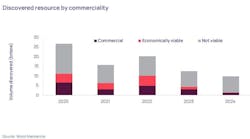Papa-Terra marks first use of dry tree floating technology offshore Brazil
P-61 TLWP is expected to start by the end of the year. (Photo courtesy FloaTEC)">
Jessica Tippee
Assistant Editor
Petrobras started production from thePapa-Terra field on Nov. 11, 2013. Papa-Terra is a heavy-oil field in block BC-20 of the Campos basin 110 km (68 mi) offshore Brazil in 1,190 m (3,903 ft) of water. Petrobras is operator with 62.5% interest while Chevron holds the remaining 37.5%.
Discovered in 2003, Papa-Terra's reservoirs contain 14-17° API crude. In January 2010, Petrobras and Chevron sanctioned the $5.2-billion project that is estimated to recover 380 MMbbl of heavy oil. Development consists of an FPSO, the first tension leg wellhead platform (TLWP) in Brazil, and a tender assisted drilling unit.
In February 2010, the Papa-Terra partners contracted BW Offshore and QUIP to convert the 323,000-dwt ultra-large crude carrierBW Nisa into the FPSO P-63. QUIP contracted AMEC to perform basic engineering services for the topsides facilities that include three oil processing modules; one gas compression module; three electrical power generation modules; two water treating and injection modules; one electrical building module; three utilities modules; one flare system module; and two manifold modules. The vessel was converted at the COSCO Shipyard in China, with final integration performed in Rio Grande, Brazil.
The FPSOP-63 is 1,115 ft (340 m) long, 190 ft (58 m) wide and 92 ft (28 m) high and supports topsides that weighs 18,500 tons. It has the capacity to produce up to 140,000 b/d of oil, to compress 35 MMcf/d (1 MMcm/d) of gas, and to inject 340,000 b/d of water.
The vessel will connect to five producer wells and 11 injector wells using 27 km (17 mi) of integrated production bundles (IPB) of risers and flowlines from Technip. The IPB technological solution increases the temperature of produced fluid after long shutdowns in order to reduce viscosity and enable well production restart.
QUIP contracted Wärtsilä to supply three main power modules, which each include two 18-cylinder 50DF tri-fuel engines in V-configuration, as well as alternators and auxiliary equipment. Wärtsilä says this is the first FPSO to employ gas engines to produce more than 100 MWe of power. Hamworthy provided the cargo pump room system, firewater pump system, and seawater lift pumps.
QUIP also awarded Veolia Water Solutions & Technologies a $39-million contract to supply a water treatment package for the FPSO. The equipment, designed to treat seawater, consists of pre-treatment and seawater sulfate removal systems, which also will strip other divalent ions from injection water to enhance oil recovery.
In April 2012, InterMoor installed 15 drilling and production conductors for the FPSO. Fabricated at its 24-acre facility in Morgan City, Louisiana, the conductors are 36 in. (91 cm) in diameter and 187 ft (57 m) long. The company chartered theSkandi Skolten, DOF Subsea's construction anchor handling vessel, and the installation barge with a custom conductor launch system. For conductor driving, InterMoor used MENCK's MHU-270T DWS, which included a deepwater hydraulic hammer, at a water depth of 3,281 ft (1,000 m) combined with MENCK's girdle-type electro-hydraulic power pack and umbilical support system. Generating hydraulic power at depth, rather than at the surface, means no hydraulic hose.
Displaying 1/2 Page 1,2Next>
View Article as Single page




